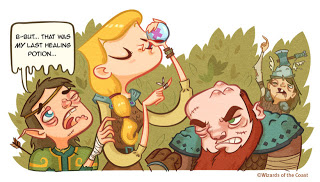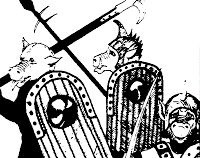One of the things that plagues some D&D games (my own included, on occasion) is what is known as “the fifteen minute workday problem”. To wit, characters in a dungeon go through two or three rooms, find themselves down some hit points and/or spells, and then return to the surface, heal up and re-memorize spells to return on the next day. Or, alternatively, they barricade themselves in a room and camp out in the dungeon itself. It’s a problem that especially presents itself in lower-level games, because the spell casters have few spells and must recharge more often.
There are some tricks a game master can employ in order to discourage this behavior. Locking the player characters in the dungeon (whether literally or by simply denying them egress through having them get lost, having monsters block the exit, etc.), disrupting spell-casters’ rest with random encounters, etc. But it’s very easy to overdo these sorts of things, however, and can begin to smack of “the DM is just going to punish us for leaving, so we might as well keep going until we’re dead” in the minds of the players.
4E attempted to address this problem at least in theory with its classification of powers as being per-encounter, per-day, etc. To my mind, however, that was a bit too “gamey”, and lacked any sort of real in-game justification. But the problem is certainly not unique to 4E; it’s existed since the beginning of the game.
I wonder, though, if there is some way of addressing this issue in a way that doesn’t offend my grognardly sensibilities? On the one hand, part of the whole aesthetic of an old-school game is resource management. It’s not just about making the right tactical choices in a combat, but making the right operational choices when selecting spells and buying equipment. In once sense, the megadungeon is its own solution to the problem; if the game master doesn’t slack off when it comes to rolling for random encounters, the mere fact that the player characters may well need to fight their way out will encourage them to stay in longer. But that just shifts the site of rest to a barricaded room inside the dungeon, rather than the local inn or convenient cave near the site of the dungeon.
There is one solution to the problem, which applies perhaps more to the megadungeon environment than a smaller encounter area, but I’m sure the principle could be applied.
The monsters get tougher (or, perhaps, more wary) if the player characters keep coming in and doing hit-and-run sortees.
Not in the sense that they somehow get bonuses to hit, or more hit dice, but in the sense that they become more organized. They’re more on their guard. Patrols are more frequent. Rooms and corridors are restocked with guards, ready to send out messengers to alert the leader to the renewed presence of the intruders. Once the player characters clue into the fact that the monsters will be waiting for them (perhaps even with traps, ambuscades, tougher monsters from deeper within the dungeon who are brought up as reinforcements, etc.), they may decide that two-rooms-a-day is not the best way to go. Maintaining the momentum, and thereby the element of surprise, becomes a superior (and thus preferable) strategy.
Naturally, this doesn’t mean that resistance can’t stiffen during the player characters’ foray. Just because they haven’t returned to the surface doesn’t mean that the orcs will automatically stay in their rooms, conveniently grouped in 3’s and 4’s, perfect for slaughter and easy x.p. But that should be a more “ad hoc” thing on the part of the defenders (except for those very lawful humanoid tribes that have contingency plans already in place, complete with pole-arm-wielding troops to command narrow corridors and such), and to be expected. The idea is that pressing on should be the preferable option to retreat, except when the resources of the party really are exhausted, and R&R becomes required.













This is a tough issue. As a DM (and even a player) I get annoyed by the constant hit and run tactics and the 15-minute workday.
On the other hand, one of the principles of old school D&D is, as you say, resource management. And part of that "management" is being aware of when you are low on resources. So yes, I get annoyed at times. But then I think about it and figure that's part of their survival strategy.
It also depends on party size. In my group, we usually have parties of 2-4 characters (never more than four). With these parties, they simply can't handle more than 3-4 significant encounters before they're half-dead and out of spells.
For a more conventionally size party (6 or more), I wouldn't think they should flee the dungeon every couple rooms. If this is the case, either (a) they are VERY skittish, (b) they're not playing intelligently, or (c) the dungeon is extremely difficult.
My two cents – disorganized as they might be.
I'd take it a step further and say that the design of the adventure has to reflect the make-up of the party (at least on some level). You don't send newbie RPGers into the Temple of Elemental Evil and expect to get anything out of it except dead characters.
This makes it doubly hard, since an incorrect pairing of party to dungeon will end with death or boredom and a double helping of frustration.
Returning to the ToEE example, the module included rules for reinforcements and new recruits, meaning that time was an issue since the dungeon would restock losses and then eventually exceed its original capacity if the party failed to keep the pressure up.
While the Temple contained more than its fair share of save-or-die and no-save-just-die, it also contained deliberately engineered weaknesses for the party to exploit, such as the inter-temple rivalries between the elemental cults on level 2, and a few areas of No Man's Land which could be turned into temporary shelter if need be.
Sadly I see very few published adventures with this sort of quality built in.
Hmm. I've never really had a problem with this — That is to say, it doesn't bother me.
Since they fought their way "in," I always allow that "the way out" is clear of monsters. I also don't role play the sleep cycle, so again not problem.
That's not to say that the rooms they visited will not be repopulated — with monsters, not treasure.
So the next time, they get to fight the same two or three rooms, without reward.
There are several ways to counter this;
1> The old style dungeons were filled with one way doors, sliding walls, turn table rooms, teleportation rooms and doors, collapsing walls and ceilings, chutes and slides, collapsing floors, doors that get locked by monsters behind the party, and many other ways to change the route out from the route in.
2> Old style dungeons used to have plenty of shiekers and alarm bells summoning more opponents. If there were five goblins in a room in a fight with the party then usually one or two would run away to get more help.
3> Some monsters would keep captured opponents and pets as 'dead man' switches. Kobolds might have an ogre in a cage or behind a concealed wall that they will release if they are getting clobbered in a fight. Large creatures like dinosaurs and animals are favourites for this kind of thing too and gives the ranger and druid something to practice their woodland talents on in a dungeon (or make the player told his class choice was stupid turn to the others and point to the reason he was an asset).
4> Dungeon Crud! It is like convention crud only a dangerous side effect of going into dungeons. Any entry into a dungeon results in every player needing to take a health roll the next day or start suffering ill effects of fever and deteriorating abilities. If you run the risk of getting ill then you had better make it count because it might be a week before the whole group is fit to adventure again. A week of camping outside the dungeon with players recovering from illness should lead to plenty of encounters not on the player's time table.
5> Chase the players down. Organize hunting parties and disrupt the player's time table of behaviour. If the players feel they can camp a mile away from a dungeon without problems then teach them that they are still going to be persued as they set up camp. Have a few monsters throw fire brands or fire arrows on their tents or shoot the horses from the trees. Players will learn that going in and out of the dungeon does not mean stopping outside the front door of the dungeon.
6> Bigger room battles. I use this often now. I have several smaller threats spaced twenty to thirty feet apart inside of a larger area with side rooms. The threats are within ear shot enough that they can support each other but they are not part of 'one' group. The players must decide how to allocate resources to the different groups as they arrive. You can also add a few waves to a room that will cause players feeling they 'won' because they burned all their toys in the first couple of rounds to realize they are in for a longer fight.
One of the ways I deal with it s to build it into the experience points. The major source of experience is “total monster level in excess of total PC group level, calculated between rests”.
So if they kill 13 levels of monsters, and have 15 total PC levels, they don’t get that experience.
The other thing I do is if they leave and let their opponents regroup, their opponents will regroup and learn from the previous encounter—including, potentially, learning what the PCs are after.
My main problem tends to be “you’re down to a couple of hit points per character and some of you are injured. You’re going cross the rope bridge over a bottomless chasm into an unexplored area of the caverns? Alrighty then.
There was a great pair of articles in White Dwarf 38 (that spoke to this problem (at least in part): "Monsters Have Feelings Too" by Oliver MacDonald and "Extracts from the Uruk-Hai Battle Manual" by Graeme Davis (and in particular the latter).
Playing monsters that are as intelligent as average humans (and even if your standard orc isn't, its leaders probably are) means that they should probably start to take precautions, set traps, patrol within and outside of their lair, even have a party hiding in ambush to pin the PCs from behind or to attack them on their way out of the level.
An enemy left alive at the end of the day, is an enemy that now knows more about you and your tactics, and your weaknesses—and if the enemy is smart, they'll exploit that intelligence.
Allan.
I'm not entirely sure this fits the Old School angle of this discussion, but my own (untested) house rules (sort of Old School/D20/a little 4e) were written around this issue.
Characters are always able to do at least some minor healing inbetween encounters (First Aid/Flagon of Ale).
Wizards have access to Ready spells which may be cast at anytime (low level spells) and have a level-defined number of encounter spells, which recharge after a ten-minute rest from all spellcasting. Some spells have been modified or even eliminated, as well.
It really does boil down to a simple maxim: The PCs resting is only a problem if the rest of the world also goes to sleep.
Whether it's reinforcing, killing the hostages, completing the ritual, building barricades, putting up traps, or even just packing up the treasure and leaving there are a lot of reasons the PCs shouldn't spot the opposition 23 hours of prep time.
It takes a static, boring game world for the 15-minute workday to be cpnstantly effective.
4E is actually quite terrible at this, BTW. It still rewards the nova cycle (burning out your most powerful abilities in a single encounter and then resting to get them back), it adds a hard limit to healing (once you're out of healing surges you HAVE to retreat), and the encounter balance is razor thin due to the game's elimination of strategic gameplay (you can't let the monsters reinforce because the resulting encounter will be a TPK).
Check out Revisiting Encounter Design, Death of the Wandering Monster, and How to Use Published 3rd Edition Modules for more thoughts on how the design methodology for adventures has gone completely out of whack in the last decade.
Sorry, duplicate post.
This issue does boil down to game rules vs. game world. The players are playing to maximize the rules. The DM is playing to enhance the game world. Neither side is wrong, since D&D is a game and an impromptu narrative, but the "15 minute workday" emphasizes that dichotomy.
I never really had this problem. Second visits are just much more deadly as the denizens are much more likely to be ready (if not organized.) I hear more quotes like "kill them while we still can" rather than "let's go out and rest up for more spells". But most of the baddies are humans in our games, which have more chance of coordinating resistance.
*Discourage* the players from returning to town every time they run a little low on resources? I'm trying to *encourage* them to do that!
It doesn't have to be easy, and things can certainly change between visits, but I think there should be a series of short expeditions instead of "hanging on until the last hp".
If the dungeons inhabitants are sapient, a possible tactic is to have them bring the battle to where the party is resting outside the dungeon. Nearly being burned alive when goblins try to raze the village might make the need to deal with them 'once and for all' apparent…
I'm getting the feeling that many of you here like TPKs — Total Party Kills. Makes me glad that I'm not playing in any of your games.
When a player's character has had enough — he's had enough. I'm not killing my players off. If they die during the fighting, that's one thing. Insisting that they remain in the dungeon, or that they fight their way out, when they're down to 1 hit point — that's just a DM who likes killing his players characters.
I just quit a game over that. So did everyone else. We informed this person that he would not be allowed to DM anymore — if he wished to stay with our group. (We take turns DMing our own games) Now, he just a player.
As Talysman has suggested, the DM should encourage characters in such a dire position to "run" — be it back to town or a barricaded room.
Money and time are other resources to manage. Doing 15min of loot gathering vs 1 (or more) day of supplies/henchmen pay should not be a viable business plan.
verification: "Flamorod" best wand of fire name ever.
Mystic Scholar, the 15-minute workday as described here isn’t about getting to a handful of hit points and leaving; it’s more about taking a handful of hit points and leaving. That’s what makes it a short (i.e., 15-minute) excursion.
Agreed. If the party has a serious dent in their resources, the inhabitants of the dungeon are also going to be busy taking care of the fallout from the party's excursion on their side.
If the party is just treating the dungeon as a consequence free shooting gallery. "Hit the kobold! Get a prize!" then the monsters should be setting their camp on fire.
Funny thing about this : I never considered that "problem" per se of editions…more than features.
Spellcasters with few resources, rules that forced players to the hit and run tactics etc…
I always faced it as a feature of the game framework we play and worked with that premise. Which is also why I can not see how a rules change will actually save this. 3rd and 4th editions might have managed to prolong the expected duration of a dungeon ran but still the players would need a rest. So maybe it is not after 3 encounters but after 10 or 20…what is the difference? Put to scope the size of the dungeon and the resistance you build for them and you still can modify it down to only 3 encounters before they need to rest or to 30.
It is all a matter of understanding as DM the tools you have and putting them to action. If the rules do away with that how then will you build a dungeon that the players MUST experience the feeling of loosing resources and yet have to press one because they are on a timed mission? Or the one off to really scare them where they have to survive a dungeon on player intelligence and ingenuity rather than powers and skills on their characters (I will never forget the time I managed to have 4 players of 12-16th level down a pit in Baba Yaga's module in a way that they could not climb up and neither could they rest!!! It was amazing and we never got frustrated we just enjoyed this off chance of an encounter)
To sum up, my personal opinion is that when these kind of problems crop up it is more the fault of the DM rather than the ruleset. (You want players to last longer even in an old school 0 or 1st edition include a fountain of resting and recuperating…)
I like Jerry's idea. But in actual play I find this is rarely a problem. Even with a first level party the availability of spells and hit points seems perfectly timed to our 3-4 hour sessions. Once or twice a party has actually taken two sessions between rests.
What helps is if the game is made interesting by exploration areas, not just a constant gauntlet of hazards. If the 15 minute workday is uninteresting it is probably because the dungeon is an encounter zoo.
In my own game, I use a mechanic called "shake it off".
Basically, whenever injured, damage up to CON + LVL can be "shaken off" (it just wasn't as bad as you thought) and the character keeps going. Shaking it off requires at least 5 minutes of rest and/or attention to wounds. Any damage remaining after shaking it off cannot be later shaken off, but must be healed normally.
If you are knocked unconscious (reduced to 0 hp), you are not dead until you reach your Shake it Off potential in negatives. I.e., if you can shake off 13 points of damage, you die at -13.
Being knocked out, though, can cause problems.
From 0 to -9, it simply takes longer to recover. Also, you might be bleeding out.
From -10 on, however, you are suffering from some permanent damage, which will affect you a lot now and a bit later. I.e., you have a very strong reason, even if not mandatory, to find somewhere to heal up for weeks or longer.
This is OGC from RCFG, and you may use it if you want!
Perhaps an idea, while not necessarily traditional, that would encourage player characters to press on is taking a different look at hit points.
In our games (at least when I run them) hit points represent a character's capacity to avoid getting gutted/burned/maimed/fragged/etc. The idea I fancy is that directly half of a character's total hit points are moreso fatigue points. As these wane the character drudges, slows, but is relatively devoid of noticeable damage. The other half represents when he first starts taking glances, nicks and bruises. The first half can be fully regenerated with 5 minutes rest, while the other regenerates in the standard way with proper rest and healing spells.
It lets players go a bit longer and gives healing spells and potions a sense of greater potency.
I know we do a mega-dungeon campaign that suffers greatly from the 15-minute work day. Once my cleric has spent his last heal, and the wizard, his last missile, we often resort to barricading ourselves in a room with a ward on the doorway.
This is a good solution. When my players want to rest, they never come back to the dungeon in the same state they left it. Monsters will shore up their defenses as best they can and be on higher alert. Naturally there's only so many reserves they have, but they may be able to contact allies to help out. When they leave the dungeon to camp, they might find the reinforcements coming across them. Even the less organized monsters will have some sort of alarm. After all it's a dangerous world.
On the other hand, attack the players too often when they're resting encourages the 15-minute workday. Players that expect to be attacked at night will make sure they have enough resources for a big battle when they sleep. A big battle where most of the party starts out asleep and out of their armor.
As for 4e's At-will, encounter, daily routine: this makes sense to me for spellcasters at least. Some spells are simple and you can cast them willy-nilly. Some spells can be prepared with a few minutes of meditation and study. And others are so powerful that you can only do this once per day. This makes for a more complex resource management and helps with the 15 minute workday. I wouldn't necessarily do it the same as 4e, but I like this idea.
@Mystic Scholar – there's a big swing in between the 15 minute workday and a TPK. I've seen wizards that always uses their highest level spells in the first fight and then say "We need to rest because I don't have any more cones of cold." Nobody expects them to fight to the last hp, but we do expect them to be challenged.
There are a simplier solution.Just don't create big dungeons filled with a lot of arbitrary combat encounters. Limit yourself to some tramps, and a lone big battle in the heart of the dungeon. That is not old school enough, but it works. Also, it is a lot more realistic and narrative driven.
Another simple tool is to give a time constrained motivation to enter a dungeon, not just exploration. If the PCs enter in a dungeon to rescue a princess, or to disrupt the doomsday ritual, they simply can't afford to take a rest.
This is a constant issue in any rules system requiring resource management, which is every version of D&D ever made. I try hard not to make arbitrary deadlines, but putting the PCs on the clock can achieve the desired result –although time limits will cause most parties to seek the goal as quickly as possible, with a minimum of exploring.
I also think the 15-minute workday is more prevalent in "adventure path" type games, where the sandbox/random encounter aspect is largely missing and PCs are expected to fight a major, resource-draining "boss" battle fairly frequently. Old school settings seem to favor several (5-10?) encounters per rest period; D&D 3.x explicity states that it is built for PCs to rest after roughly four encounters. This, along with the 3.x CR and XP progression system, was a design choice with large implications.
At any rate, the DM can use NPCs to remind PCs to use their potions, scrolls, and other disposable items to get them through "low resource" times.